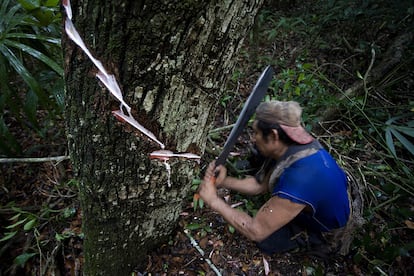Voyage to the Mexican origins of chewing gum
The Mayans called it sicté, the Spanish adopted it as ‘chicle’ and the U.S. government gave it to troops during WWII to combat stress

Originally wrapped in corn leaves to harden, it was consumed in religious ceremonies, to quench thirst, to help digestion or as a part of Mayan oral hygiene. Any history of chewing gum will begin and end in the south of Quintana Roo, where the tall sapodilla trees of the Mayan jungle of Gran Petén grow in huge numbers and whose sap has been extracted for centuries and has managed to travel all around the world.
Returning to its home, I am going to try the first and only organic chewing gum that is also biodegradable: Chicza, which has been marketed for years in Europe. Chicza is a different chewing gum. It is made from organic natural gum base together with wild and native fruits, herbs, and spices. The procedure for extracting gum is basically the same as the technique the ancient Mesoamericans used. At the Chicza headquarters, in Chetumal, I meet Manuel Aldrete Terrazas, executive director and connaisseur of the process: “The chiclero is the farmer who extracts the resin. He studies the tree, climbs and cuts it down using a machete. He makes zigzag cuts in the bark, like the mark of Zorro, so that the sap runs. “His skill is admirable.” I ask about the chiclero communities, about their means of subsistence, and Manuel emphasizes that the Mexican jungle is collective. “Within the ejidos [communal lands] there are loggers, beekeepers, and resin extractors. Chewing gum has great synergy, there are carbohydrates, fiber, vitamins, and sugars. Apart from being a natural product, this gum never hardens. You soften it with heat and moisture but your jaws don’t get tired. With other, plastic chewing gums you swallow solvents and alcohols.”
I try a lime flavored piece. I notice two things: one, I can’t blow bubbles like the Pink Ladies in the movie Grease; and two, it doesn’t take long for the taste of lime to fade away. “There are no polymers here. The chemicals in polymers make the gum behave the way you want it to. Bubbles are made by the solvents and industrial alcohols that allow the gum to inflate. Does the flavor go away quickly? No, what goes away quickly are the sugars and sweeteners. Plastic gums contain 40% pure sugar, at Chicza [we use] only organic flavoring from vegetable extracts. Go on, have another one. It’s good to relieve tension.”
I think of that scene from Friends in which Chandler is locked in an bank with a model who offers him a piece of gum. He accepts but then spits it out and, later, embarrassed by what he has just done, puts it back in his mouth and pretends to choke to get her attention. I also remember Mr. Adams’ chewing gum, which was marketed at the end of the 19th century and that anyone who was a child in the 1980s will remember by its brand name: Chiclets. “Adams found gum while looking for rubber for car tires… it was already a relic product that came from here. When the Americans went to World War II, a 1944 decree revealed the consumption of natural chewing gum was only for the troops. Now, people use fentanyl or marijuana to combat stress, but back then, chewing gum was essential,” says Aldrete Terrazas.
Sign up for our weekly newsletter to get more English-language news coverage from EL PAÍS USA Edition
Tu suscripción se está usando en otro dispositivo
¿Quieres añadir otro usuario a tu suscripción?
Si continúas leyendo en este dispositivo, no se podrá leer en el otro.
FlechaTu suscripción se está usando en otro dispositivo y solo puedes acceder a EL PAÍS desde un dispositivo a la vez.
Si quieres compartir tu cuenta, cambia tu suscripción a la modalidad Premium, así podrás añadir otro usuario. Cada uno accederá con su propia cuenta de email, lo que os permitirá personalizar vuestra experiencia en EL PAÍS.
¿Tienes una suscripción de empresa? Accede aquí para contratar más cuentas.
En el caso de no saber quién está usando tu cuenta, te recomendamos cambiar tu contraseña aquí.
Si decides continuar compartiendo tu cuenta, este mensaje se mostrará en tu dispositivo y en el de la otra persona que está usando tu cuenta de forma indefinida, afectando a tu experiencia de lectura. Puedes consultar aquí los términos y condiciones de la suscripción digital.
More information
Archived In
Últimas noticias
Most viewed
- Alain Aspect, Nobel laureate in physics: ‘Einstein was so smart that he would have had to recognize quantum entanglement’
- Maps of the US attack on Venezuela: Targets, airspace and deployed fleet
- Oil, gold and rare earth elements: the backdrop to US political tension with Venezuela
- Key points of the military attack on Venezuela: Early morning bombings and a ‘captured’ president
- The US bombing of Venezuela, in pictures











































